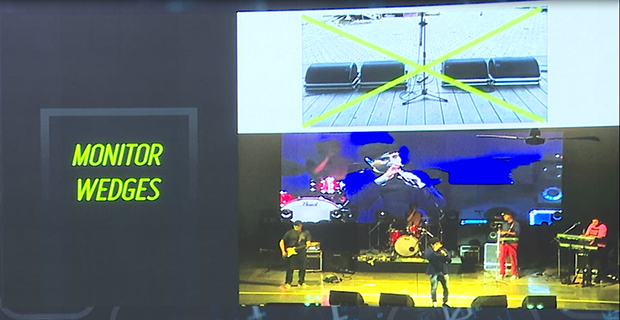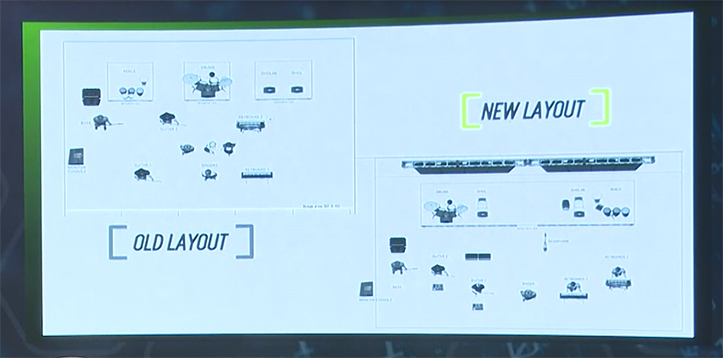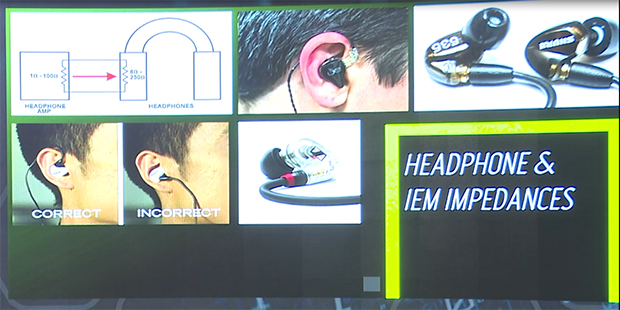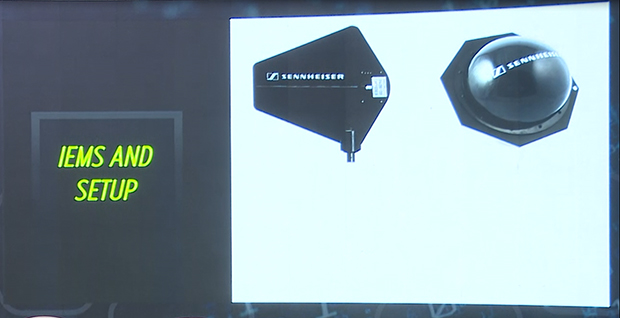PALM AV-ICN Conference Series - Monitor Mixing
Dialing it up: Ashish Saksena on how Monitor Mixing can
Elevate a Performance
What does it take to create a technically accurate monitor mix and put the stage performance on
a pedestal? Ashish Saksena, Live Sound Engineer for Shankar Ehsaan Loy & Late KK, spills the
beans on crafting a good monitor mix in PALM + AV-ICN conference session titled, ‘How Good
Monitor Mixing Can Boost A Performance.'

The Correct Way To Angle Monitor Wedges
With an undiluted passion and an ever-evolving mastery in the field of sound engineering, Ashish
Saksena has been the backbone of major stage shows involving the greatest singers of this
generation, including the famed trio of Shankar Ehsaan Loy and the evergreen late KK. As a live
sound engineer for the top artists in India, Ashish Saksena has had the front seat with regards to
the nuances that go into the profession, and how, even the minutest change in monitor mixing can amp
up a performance beyond imagination. In his conference session titled, ‘How Good Monitor Mixing
Can
Boost A Performance', Ashish Saksena takes his audience through the nitty gritty of creating
a
worthwhile monitor mix, the tips and tricks to achieving a great mix, and dealing with the
challenges that present themselves while attempting a jaw-dropping monitor mix. Read the excerpt
here.
The Difference Between Monitor Mixing & Front of House Mixing
Amateur sound engineers sometimes find it hard to distinguish between monitor mixing and Front if
House mixing. Ashish Saksena has an apt response to explain the difference. He shares, "The
difference between monitor mixing and FOH mixing is the creative aspect of the mixing. Monitor
mixing is more technical, while FOH mixing is more creative, where the engineer is just catering to
the audience, and to some extent, for himself or herself. But, in monitor mixing, you are not mixing
for yourself, but for all the musicians and the singers on the stage. Depending on the number of
musicians and singers, you are creating that many mixers. For instance, if there are five musicians
and two singers, you have to create seven mixers. So it becomes more technical."

Going Back To The Basics
When it comes to churning up a memorable monitor mix, Ashish Saksena talks about how essential it is
start from square one, with the basics. He comments, "The first step to success when it comes to
creating a good monitor mix is to position the musicians a little better. A very basic rule of thumb
is to not place the sitar player next to the drum player. For instance, in the old layout for SEL
(Shankar Ehsaan Loy), the percussion and drums are at the back, the melody section is at the front,
which includes the bass, guitar, and keyboards. It's nice, but feels a little messy too. So, we
tried a new layout, where the drums and the dhols are placed together, the dholaks and percussions
together, and the melody players are placed with the saxophone player at the front of the stage."

How To Create The Perfect IEM Setup
Stressing on the importance of IEMS and setup in making a performance-boosting monitor mix, Ashish
Saksena shares, "The IEMS and the setup are very important. The correct antenna placement, the
correct placement of the bulk packs - all of this also very, very important."
He continues, "We use fish antennas, since these are more prevalent in the industry. I recommend all
sound vendors to buy the fish antennas to replace the stick antennas. Because with fish antennas,
you can combine four to eight units and have them run off one antenna instead of having eight
different stick antennas, which could interfere with one another as well."
Saksena cautions against placing the IEM and microphone systems together, because, according to him,
One is transmitting the signal and the other is receiving the signal, and they are bound to cancel
each other."
He also further amplifies his point with an apt example. "If you have an IEM and a microphone, never
place the IEM antenna behind the microphone antenna, because the latter is usually more stronger.
Always put the IEM antenna in front of the microphone antenna." He adds, "Normally, there should be
a distance of six feet between the transmitting signal and the receiving signal. I think a distance
of two to three feet is also ideal. If you're using short antennas, keep them at a distance of at
least 6 inch between the two units. Do not stack up the antennas on top of one another. People
usually do this because of lack of space, but this actually interferes a lot with sound."

The Correct Way To Angle Monitor Wedges
To maximize the role of monitor wedges in the creation of a perfect monitor mix, Ashish Saksena has
a simple tip up his sleevs. He shares, "If you want to get more efficiency out of monitor wedges,
observe what kind of microphone the singer is using, and accordingly, angle the wedges. If your
wedges are placed in a straight line, and there is a 60-degree dispersion while the microphone is in
the middle, then it's going to leak into the microphone. Instead, what you need to do is angle them
correctly in a way that if the singer stands in the middle, the angle becomes like a null point and
the possibility of feedback reduces. This, I would say, is only true for certain patterns of
microphone, like a super cardioid microphone."
He drives the point home and states, "For a cardioid microphone, because the null point of
microphone is right at the back, if the singer is using a SM58 microphone, or even a wireless
cardioid microphone with a SM58 capsule, it is okay to put a monitor in a flat position. But if the
singer is using a Beta58, which is a super cardioid microphone or a cordless microphone with a
Beta58 capsule, then it is better to angle the monitors so that they again go into the null point."
Before The Sound Check...
Sound check is crucial to crafting a sound monitor mix. But it is even more important to ensure that
the moment before the sound check is also properly monitored. Ashish Saksena is a firm believer of
the aforementioned statement and shares tips on the right way to approach a sound check. He
comments, "Before you begin the sound check, you can put up a RTA microphone, run some pink through
the monitor wedges, and on the graphic or on the parametric, you can flatten out the peaks. The
moment you flatten the wedge, it will automatically give you a little more volume. So, if you had a
wedge with nice high mid punch to it, the moment you play a high mid instrument such as a guitar or
there is a singer who sings in the upper registers, it automatically starts peaking and ringing like
a bell."
Investing In Headphones That Don't Turn Into Mush
Cheap headphones might be good to go with our phones, but for an aspiring sound engineer, these are
a bane. Ashish Saksena, while talking about the perils of going for cheaper headphones, shares,
"Most of the time, musicians buy the cheapest headphones that they can find. It may have low
impedance, but unfortunately, it is so low that the headphones can just give up when it is connected
to a pro system which is outputting at a line level. These headphones also start saturating so much
that they turn to mush. Because of this, the musician is not able to hear his mix correctly, and
he'll keep asking you to increase the gain. My solution? Be a little more responsible, spend a
little more money, and buy something that will last a little longer."
Mastering The Art of Monitor Mixing
The first step to master the art of monitor mixing is switching to stereo. Why? Ashish Saksena
responds, "When I did pure monitor mixing, we switched to stereo for all the musicians. The reason
behind this was not because we were fascinated with stereo, it's because the placement of the
instruments could be done in a better fashion. When you switch to stereo, you can pan the toms away,
overheads even more away, therefore creating a little bit of space in the middle for the singer's
voice or for the musician's instruments."
A vital element in ensuring a successful monitor mix is tactfully using the snapshot. Expanding on
this, Ashish Saksena shares, "A snapshot is very helpful, not just for changing levels, but also for
creating mutes. If you have certain instruments which are not playing in a particular song, you can
create snapshots of just the mutes and nothing else. After some time, mixer faders go out of
alignment, you think you are at 0, but you are not. You could be at +4 and -6. But when you do it
via a snapshot and internally when that fader comes up, the physical representation of the fader may
be anywhere, but when you look at the software screen, you know you have reached its correct point."
Exploring The Nuances of Alternative Monitoring
For Ashish Saksena, alternative monitoring is very helpful. But what is it, and who does it work
best for? Saksena says, It is ideal for a much bigger band that has a larger tech crew travelling
with them. You now have systems where you can sub-group up to 24 channels to send up to 24 submixes
to each musician's station and he/she can control their own mixes."
Smaller consoles also deliver agency to musicians, allowing them to control their mixes. Speaking on
smaller consoles as a great alternative monitoring option, Saksena concludes, "Some of the smaller
consoles work on WiFi, where everything is app-controlled. If you run a small band or a small setup,
and you want to give the musicians control over their own mixes, you can split your setup in a way
where you have your console on Front of House and you have a WiFi enabled console on stage. That
acts just like your monitor console, but it can remotely controlled. You can now mix Front of House
and the musicians can control their own mixes from a monitor console which is remotely located."
Creating a good monitor mix isn't child's play. But till maestros like Ashish Saksena are here to
enlighten emerging sound engineers about making a mark in the live sound industry, the journey is
well worth it.